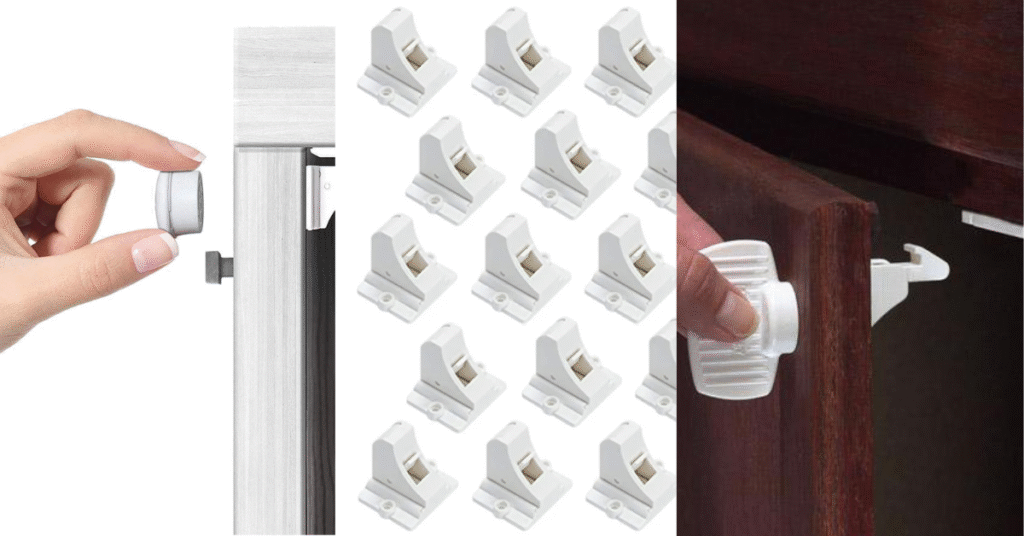
Magnetic cabinet locks are child- and pet-safety devices that mount inside cabinets or drawers, using a strong magnet key to unlock them. Because the latches are hidden behind the door, these locks remain virtually invisible from the outside, preserving your decor. For example, the image below shows how small magnetic locks (white plastic latches) attach to cabinet interiors. When the special magnetic key is held against the door, it disengages the latch so the door opens. This “no-drill” design makes magnetic locks especially appealing for renters, grandparents, or anyone who wants a subtle, damage-free solution. In practice, adults and teens can easily open the locks with the key, while curious toddlers or pets cannot break them. As one user notes, magnetic locks “work really well…super easy to install without screws…My toddler frequently pulls on the cabinets…[and] has yet to be able to break in!”. (If an adult deliberately pries hard enough, the adhesive can pull free, but little children typically give up long before that.
Magnetic locks work on most cabinet doors and drawers, provided there is enough space on the inside face to mount the latch. They are designed for a wide range of surfaces: they can attach to wood, glass-front, metal, or particle-board cabinet panels. (One manufacturer even advertises that its lock assembly “fits and can attach to wood, glass, metal, and particleboard cabinets”.) For drawers, the only requirement is a smooth inside surface and room for the latch to fit. In short, you can use magnetic locks on nearly any ordinary kitchen or bathroom cabinet, wardrobe door or small drawer. However, be cautious with porous or highly textured surfaces (the 3M adhesive may not bond well) and some thin-metal doors, as the locks may not adhere properly.
Why Choose Magnetic Locks? Uses and Advantages
- Baby and Toddler-Proofing: Magnetic locks are extremely effective at keeping children out of off-limits cabinets (like under-the-sink, medicine, or chemical storage). The latch is completely hidden behind the door, so little ones have no visible lever or strap to figure out. Because you use a magnetic “key” to open them, most toddlers cannot bypass the lock. This gives parents peace of mind and prevents pinched fingers, since the door stays fully closed until properly unlocked
- Pet-Proofing: Energetic pets (cats or dogs) often paw or nudge at cabinets. Magnetic locks offer a pet-friendly solution – pets can’t operate the key, so they won’t get into pet-food or other storage. Many families report these locks “keep pets out of areas they shouldn’t snoop.
- Travel and RV Use: In RVs or boats, cabinet doors can swing open during motion. Adhesive magnetic locks provide a lightweight, no-drill way to secure cabinets for transit. Since no drilling is required, they suit rental or leased vehicles. Keep in mind road vibrations and bumps: if you need extra security, choose a heavy-duty kit (stronger magnet and possibly screws) and check them regularly. For temporary travel use, smaller kits (4–8 locks) are handy.
- Rentals/Home Install: Because most magnetic locks use strong 3M adhesive strips, installation is drill-free. This makes them ideal for renters or homeowners who don’t want holes in their cabinets. The adhesive can usually be removed later (a hair dryer often softens it) without major damage. The hidden design also means no visible hardware – your kitchen or bathroom keeps its clean look.
Compared to strap-style or sliding cabinet locks, magnetic models win on aesthetics. They leave no ugly straps or plastic pieces on the outside of doors. Users appreciate that magnetic locks are the least intrusive visually; for example, one review notes they are “completely invisible” when mounted inside. This means you get strong childproofing without clashing with your cabinet’s finish or decor.
Installation: Adhesive vs. Screw-Mounted
Magnetic cabinet locks generally install in one of two ways: adhesive (drill-free) or screw-mounted.
- Adhesive (Drill-Free): Most kits use high-strength 3M tape or similar adhesive pads to stick the latch permanently inside the cabinet. As KidCo explains, the latch “mounts firmly to any surface using strong adhesive,” allowing a completely tool-free setup. This route is easiest for renters and for quick installation: peel-and-stick without measuring or screws. Because no holes are drilled, it’s also entirely reversible. However, the trade-off is that an adhesive-only lock may eventually peel off if a very determined child (or an adult) pulls on it repeatedly. To mitigate this, be sure to clean and dry surfaces before applying, and press the latch firmly for 30 seconds. If you worry about slipping, some users reinforce adhesive locks with extra tape or command strips.
- Screw-Mounted (Hard-Mount): Some magnetic lock systems come with small screws and templates for a more permanent installation. In this method, you drill pilot holes and screw the latch into the cabinet interior. Screw-mounts are more work but offer maximum strength. If you have strong-willed children or move the unit frequently (like an RV), a hard-mounted lock won’t peel off no matter how hard it’s pulled. For example, Safety 1st’s heavy-duty lock set uses screws and is known to “withstand strong pulling, making [it] a great option for safeguarding” even persistent tots. The downside is that you’ll need a screwdriver and more time for precise alignment. Also note screw-mounts aren’t renter-friendly, since they leave holes when removed.
Overall, drill-free adhesive locks score higher on ease of installation and renter-friendliness, while screw locks score higher on sheer holding power. Many kits include both options (adhesive tape and small screws) to let you choose.
Product Comparison (Price | Strength | Installation | Look)
| Brand | Price | Install Type | Strength | Best For |
|---|---|---|---|---|
| Jambini | ~$13 | Adhesive | Medium | Renters, Baby-Proofing |
| Vmaisi | ~$30 | Adhesive + Screws | Strong | Whole-Home Proofing |
| Safety 1st | ~$29–50 | Screw or Adhesive | Very Strong | Heavy Use, Pets |
| KidCo | ~$25 | Adhesive | Strong | Aesthetics, Daily Use |
Each of these top picks is highly rated and reliable. In general: adhesive kits (Jambini, KidCo, Vmaisi) are easiest and renter-friendly; screw kits (Safety 1st, optional on Vmaisi) are toughest and permanently mounted. All are color-neutral (usually white) and hide behind the door, so none spoil your cabinet’s exterior style.
Cabinet Types and Special Uses
- Drawers vs. Doors: Magnetic locks can secure both cabinets and drawers. The latch can attach to an inside face of a drawer or door, with the magnet mounted on the back of the door frame or adjacent wall. BestReviews notes explicitly that “you can use a magnetic lock on almost any small door or drawer” as long as there is clearance. If a drawer pulls out flat (without space behind), you may need a different style (spring latch), but most standard drawers allow a magnet lock on their interior sidewall or bottom edge.
- Double-Door Cabinets: For double-door setups, you generally treat each door like a single cabinet. You could install one lock on each door, or install one in the cabinet frame to lock both (depending on the latch design). Some models come with flexible latch straps (non-magnetic) for double doors, but with magnet locks you typically use two latches. Plan your placement so one door won’t swing open accidentally. As a rule, magnetic locks can handle any typical cabinet configuration as long as the latch and magnet align when the doors are closed.
- Glass-Front or Metal Cabinets: Many magnetic locks are designed to work on glass-front kitchen cabinets or metal lockers. For example, Rev-A-Shelf’s system explicitly says it “can attach to wood, glass, metal, and particleboard cabinets”. Similarly, a CabinetstoGo product notes its locks “install on the inside of a wood, glass, metal, or particle board cabinet door or drawer”. In practice, for a glass door, you’ll attach the latch to the glass or frame and ensure the magnet (inside or outside) aligns. Just ensure your adhesive is rated for glass (very smooth surfaces), or opt for the screw-mount version if in doubt.
Recommended Magnetic Locks (with Comparisons)
Below are some top-rated magnetic lock systems and how they compare on price, strength, installation, and look:
Best for Renters: Jambini Magnetic Cabinet Locks
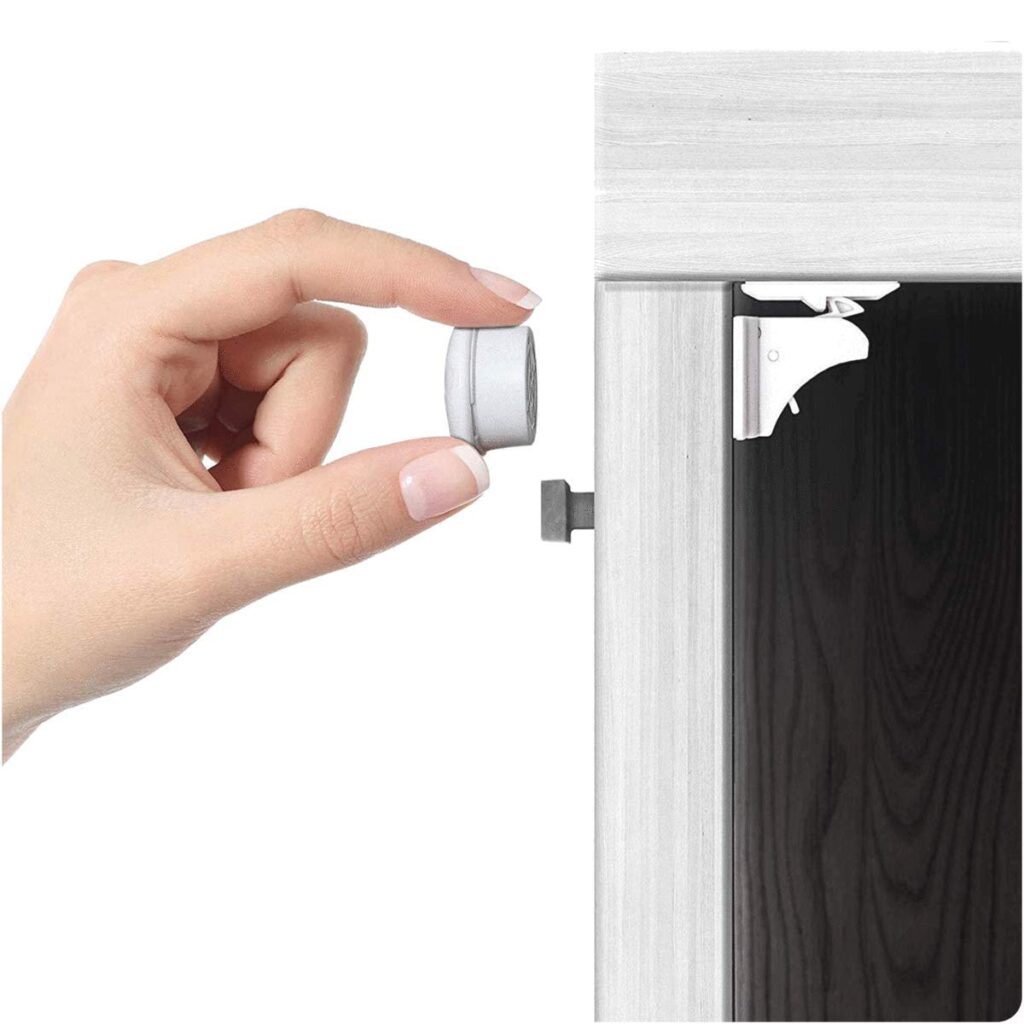
Jambini Magnetic Cabinet Locks
From: $14.99
Jambini Magnetic Cabinet Locks – Invisible, Drill-Free (Best for Renters). This popular kit (typically 4 locks + 1 key for about $14) is Amazon’s Choice and a top pick on reviews. Jambini locks use strong 3M adhesive, so no screws or tools are required (great for rentals or quick installs). They are very slim and hidden, as one owner notes: “super easy to install with 3M adhesive…No screwdrivers required!”. (Some users with overactive toddlers reinforce the tape or use Gorilla double-sided tape for extra hold.) The trade-off is that adhesive locks are less permanent than screws – a very determined pull can eventually peel them off. These locks do not work on metal cabinets, however, so keep to wood/glass cases. Overall, Jambini offers excellent value for babyproofing — affordable, discreet and flexible.
Best for Whole-House Proofing – Vmaisi Magnetic Child Locks
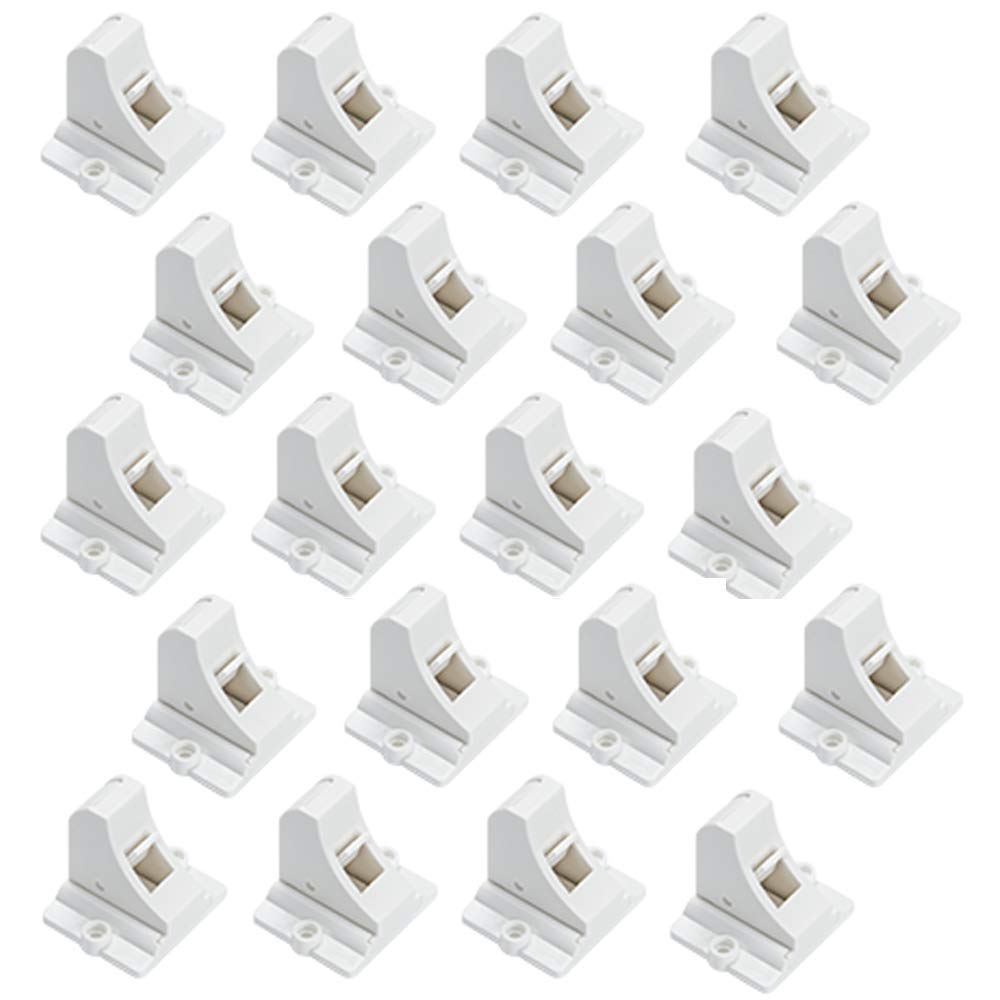
Vmaisi Magnetic Child Locks
From: $40.99
Vmaisi Magnetic Child Locks – Bulk Pack with Optional Screws (Best for Whole-House Proofing). Vmaisi kits come in large counts (e.g. 12, 16 or 20 locks plus keys) and cost around $30–40 per set. They include premium 3M adhesive pads and even paper templates for lining up the latch perfectly. Uniquely, Vmaisi provides optional screws for a more permanent mount if needed (helpful on tricky surfaces). Their locks are very strong and durable, suitable for kitchens, bathrooms, or laundry. One downside: some buyers report the provided adhesive tape can require extra care (and surfaces must be prepped well). If strength is critical, Vmaisi’s combination of adhesive plus screw options is a major plus. Aesthetically, these are fully concealed and match cabinet interiors, earning praise for being “invisible” when installed.
Best for Strength – Safety 1st Magnetic Locking System
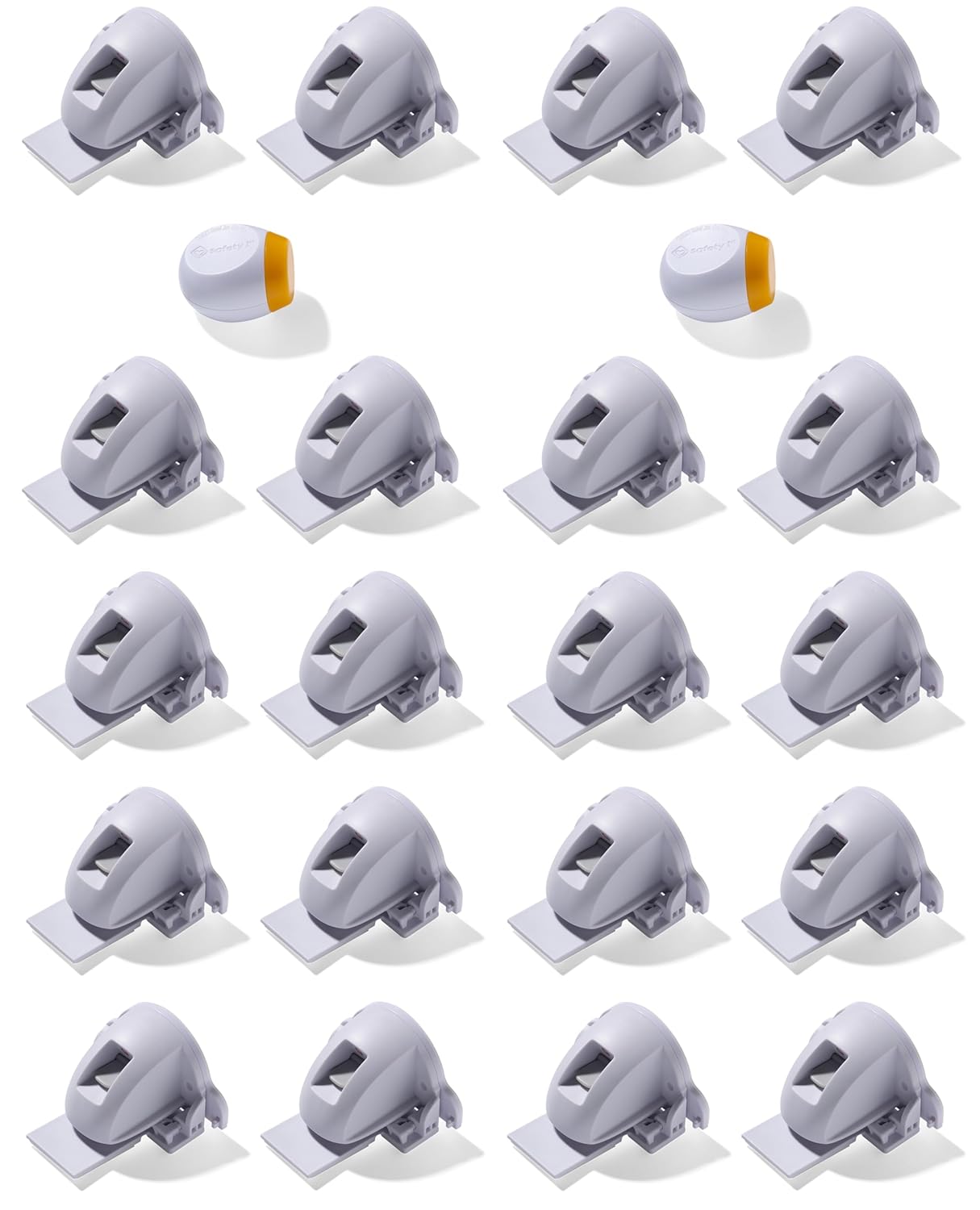
Safety 1st Adhesive Magnetic Cabinet Locks
From: $49.99
Safety 1st Magnetic Locking System – Heavy-Duty, Screw-Install (Best for Strength). Safety 1st offers two versions. The adhesive kit (20 locks + 2 keys) is a higher-priced set (around $50), boasting a “durable, strong” magnetic hold. Even better is the screw-mounted 8-lock kit (about $29). This version requires drilling small holes to install each latch, which makes it extra secure and hard for any child to defeat. Owners say it “held up after a year of abuse from a very persistent [toddler].” Properly, the lever also features a disengage lever for times when you want free access. The downside is the installation effort: you must align each lock very carefully, or it might not latch properly. If ultimate security is your goal (pets, RV stability, or very inquisitive kids), Safety 1st’s screw kit is one of the strongest in the market.
Best for Ease & Aesthetics – KidCo Magnet Lock Set
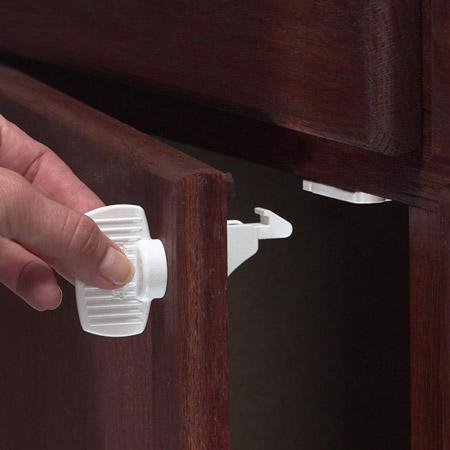
Kidco Magnet Lock Set
From: $25
Kidco Magnet Lock Set – Compact, Decorative, Keyed (Best for Ease & Aesthetics). KidCo’s 4-pack kit (~$25, including 1 key) is a smaller system ideal for a few cabinets. Its white oval latches are slim and blend well with modern cabinetry (KidCo advertises they “blend seamlessly with your home decor”). Installation is via adhesive backing, and the magnetic pull is rated strong – KidCo highlights the “powerful magnet” that “remains engaged, even with frequent use”. A handy feature: each KidCo lock has a built-in adult-release mode so you can flip the latch open from the back without needing the key (great for kitchen drawers you open constantly). This makes the locks even more convenient during daily use. In summary, KidCo’s set is easy to install, very clean-looking, and user-friendly – a solid mid-range choice if you don’t need dozens of locks.
Other Options: Several brands make similar kits (e.g. Roving Cove, Baby Proof Me, VEVOR, etc.). These generally offer 10–20 locks per set, adhesive installation, and a couple of keys. Their features (strength, ease) are comparable to the above. When choosing among them, compare how many locks you get for the price, whether screws or templates are included, and check that the adhesive quality is good in reviews.
Key Features to Consider
When shopping for magnetic cabinet locks, compare models on the following factors:
- Adhesive Quality: Look for brands using high-grade 3M or equivalent tape. A weak adhesive will fail under stress. Reading reviews can confirm reliability. The latch surface should be smooth, and instructions will recommend cleaning with alcohol for the best grip. Good kits often include a plastic alignment template to position the latch exactly.
- Magnet Strength: The magnet must hold the latch against child-strength tugs but still allow easy opening with the key. Many kits use neodymium magnets rated around 10–20 pounds of pull force. User feedback suggests that most toddlers cannot overcome the lock (one parent wrote that even after a year, “my persistent four- and two-year-old” never busted a screw-mounted lock). By contrast, an adult can usually rip off an adhesive lock if enough force is applied. If you need extra strength (pet-proofing heavy cabinets or RV motion), opt for a kit advertised as “heavy-duty” or use screw-install.
- Ease of Use: Good kits include a template or guide for alignment, and clear instructions. Battery-free operation means no charging needed. Some locks offer an **“unlock” or disengage mode: you twist or set the latch from inside so the cabinet stays unlocked until re-activated. This is handy for days you’re using the cabinets heavily or once children outgrow them.
- Aesthetics: Because magnetic locks sit out of sight, they are inherently more attractive than straps. All locks here come in neutral colors (usually white or black plastic). Kits like KidCo or Safety 1st emphasize that their latches “blend seamlessly with your home decor. Unlike bulky external locks, magnetic ones allow your cabinet hardware and finish to remain unchanged. If style is a concern, look for descriptions like “invisible” or “discreet” in reviews.
- Price: Prices vary widely by pack size. Small starter kits (4 locks + 1 key) run about $10–25. Larger packs (12–20 locks) cost $25–40 or more. For example, Jambini’s 4-lock kit is about $13, while Safety 1st’s 8-lock screw kit is about $30. Multipacks are more economical per lock but may be overkill if you only need one or two locks.
- Compatibility: Check that the lock you choose is rated for your cabinet thickness (most work on doors up to ~1–2 inches thick). Also note that very thick glass cabinets or metal-faced cabinets may not be supported by all models. Many vendors explicitly state “works on wood, glass, metal, particleboard, but one brand cautions that its adhesive locks “do not work with any metals”. Always check the fine print or packaging.
FAQs About Magnetic Cabinet Locks
Are magnetic cabinet locks safe for all cabinet types?
Yes, they are safe for most wood, particleboard, and glass-front cabinets. They mount on the inside, so your furniture stays damage-free. Just note that adhesive versions may not stick well to porous or textured surfaces, and thin-metal doors may need screw-mounted locks instead.
Can magnetic locks damage furniture?
Adhesive locks typically don’t damage cabinets since they use removable 3M tape. If you ever want to take them off, warming the adhesive with a hair dryer helps remove it cleanly. Screw-mounted versions are more permanent and will leave small holes.
Do magnetic cabinet locks work on metal doors?
Some models do, but not all. For example, Jambini adhesive locks don’t work on metal. Always check the product details. For metal cabinets, a screw-mounted kit or a brand rated for metal surfaces is the better option.
What’s the strongest magnetic cabinet lock?
Safety 1st screw-mounted locks are widely considered the strongest because they’re drilled in place and won’t peel off. For drill-free options, Vmaisi heavy-duty adhesive locks are a popular choice thanks to their reinforced magnet strength and optional screw support
Final Advice
When buying magnetic locks, plan which cabinets/drawers you need to secure. Measure interior depth (for latch clearance) and door thickness. If you live in a rental or RV, prioritize adhesive, drill-free locks and consider kits with multiple keys. If you want heavy-duty (pet-proofing or permanent home use), include at least one screw-mounted lock for key cabinetry. Always follow the manufacturer’s alignment template closely – improper alignment is the most common reason for a lock to fail. And remember: once installed, these locks keep tabs on cabinets out of reach and sight of little ones, while you can peek inside or grab what you need in seconds using the magnet key
